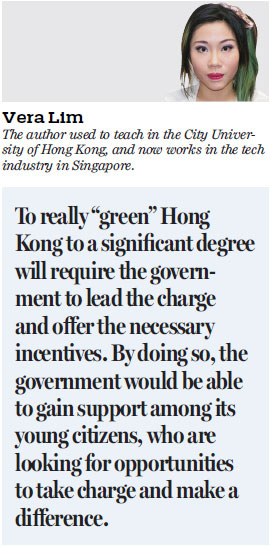Garden city Singapore is an ideal model for going green
Updated: 2018-05-07 07:07
(HK Edition)
|
|||||||||
Hong Kong's concrete jungle of skyscrapers makes for striking photo opportunities. However, its uniformity and lack of greenery can exhaust the eyes - which is perhaps one reason why parks and hiking trails are often packed on weekends.
Fortunately, there are social enterprises like Rooftop Republic which aim to let city dwellers incorporate nature into their lifestyles by turning rooftops into farms. It's laudable that their farming initiatives are all founded from the ground up. However, I believe that to really "green" Hong Kong to a significant degree will require the government to lead the charge and offer the necessary incentives. By doing so, the government would be able to gain support among its young citizens, who are looking for opportunities to take charge and make a difference. Leaving it to the few social enterprises to make urban greenery happen while facing resistance from big developers, not to mention bureaucratic obstacles, is well-nigh mission impossible. In this regard, there are lessons to be learned from Singapore, which proudly and justifiably wears its nomenclature as the "City in a Garden". It has recently made the news for building a billion-dollar indoor forest and waterfall in its airport. That's on top of the Gardens by the Bay, a superpark on 101 hectares of prime urban real estate, and the Singapore Botanic Gardens, which was recently officially recognized as a UNESCO World Heritage Site.

These impressive world-class gardens boost Singapore tourism and enhance the city's liveability. The secret of its success lies in how it strategizes from the grassroots level to ensure they're able to optimize urban residential spaces for greenery and recreation.
Most Singapore residents live in apartment blocks, the majority of which are public housing developed by the Housing Development Board - which makes it easier for the Singapore government to lead by example when pushing green initiatives.
Greenery is said to offer psychological benefits as it's a relaxing color for the eyes and believed to have a calming effect on the human psyche. Every housing board neighborhood offers plenty of green not just at ground level, but increasingly on extended elevated common corridors at mid-building connectors between different blocks. Other significant benefits of greenery are that it helps reduce heat build-up, which in turn decreases reliance on air-conditioners and subsequently global warming.
Ensuring every neighborhood has a dedicated green corridor might be a lot to ask in Hong Kong but social enterprises could play a big role in "greening" Hong Kong if they have government support. For example, instead of leaving it to those organizations to reach out to the relevant government offices for approval, the government can create a list of potential public garden areas and allocate these to the relevant organizations to lead and develop, or offer grants to buildings that are willing to take the initiative on creating community garden areas on their rooftops and common ground areas.
Besides these highly visible green initiatives, Singapore's housing board has been rolling out smaller (but equally important) energy-efficient, water management, and waste management features in neighborhoods. These could be put in place in Hong Kong without heavy investment.
For a start, motion sensors can be introduced in stairwells to provide on-demand lighting, reducing energy consumption. During my time in Hong Kong, my stairwell lights were always on even though it was rarely in use. Besides saving energy, building owners would also save on the costs of leaving these lights on 24/7, creating a win-win situation for all concerned.
In light of Hong Kong's waste-disposal problem, making it easier for residents to dispose of recyclables through dedicated recycling points in every residential building could help cut the amount of waste generated and have other benefits.
There are already Hong Kong startups such as HK Recycles which help businesses and households recycle as much of their waste as possible; their impact would be magnified with government support. To encourage recycling, Singapore organizations can apply for a grant that covers as much as 80 percent of the costs of implementing recycling projects, which reduces barriers to entry when it comes to going green.
In land-scarce cities like Singapore and Hong Kong, it's easy for the environment to bear the brunt of development costs, and that's why it's extremely important to have legislation in place to protect the environment. Thus Singapore has laws around building control and environmental sustainability for new buildings. If a new development is built, developers have to replace greenery they removed. On top of this, every new development needs to be assessed on its environmental sustainability and granted a "Green Mark" which determines whether it can be built.
With the amount of new development in Hong Kong, a compulsory "green" test could really help ensure development doesn't come at too great a cost to the environment. It should not be hard for the Hong Kong government to exercise its political will and leadership in this green initiative which can only have a triple-win outcome - for itself, the people and the environment.
(HK Edition 05/07/2018 page7)